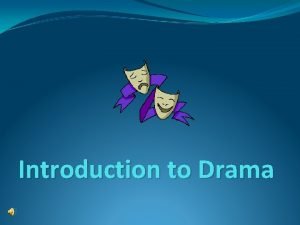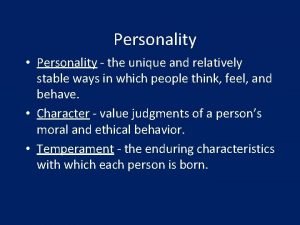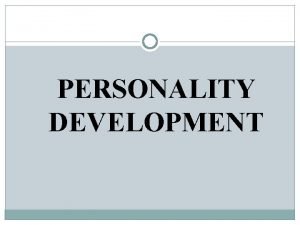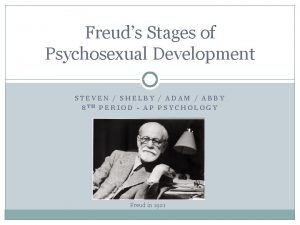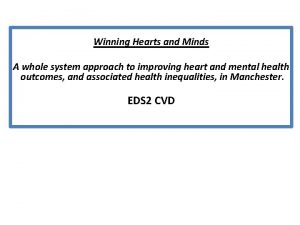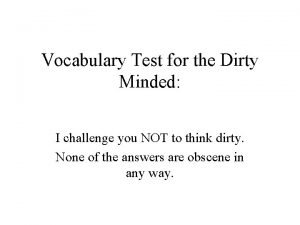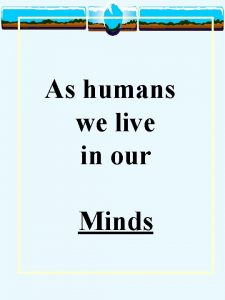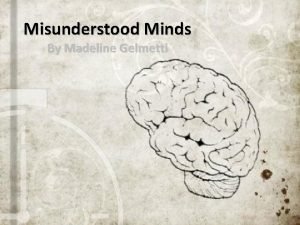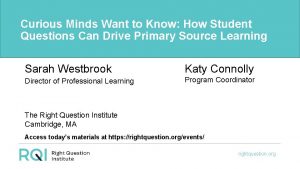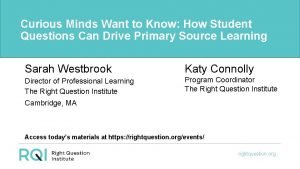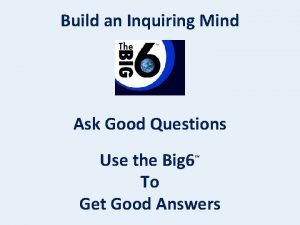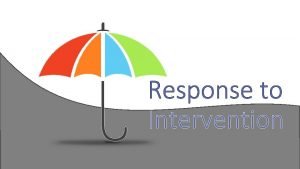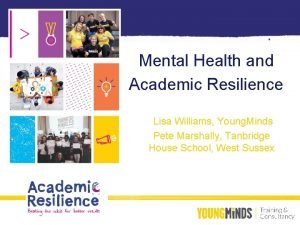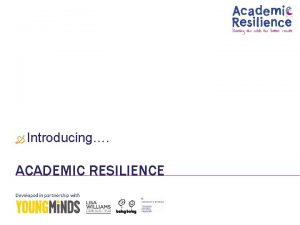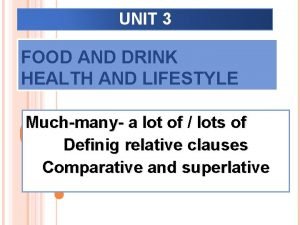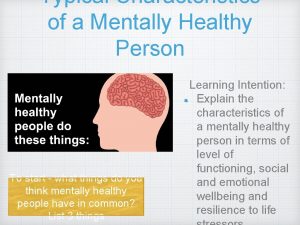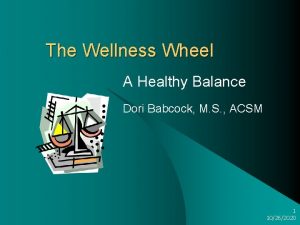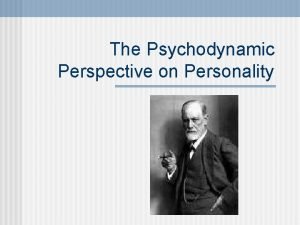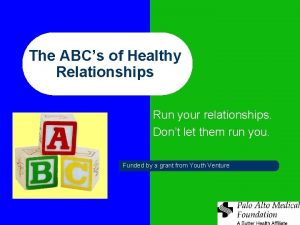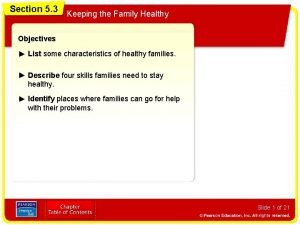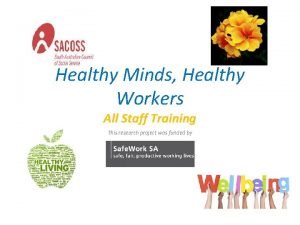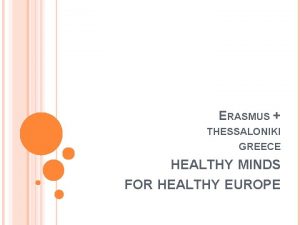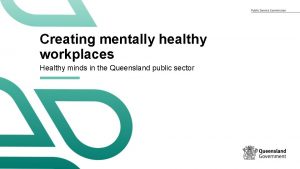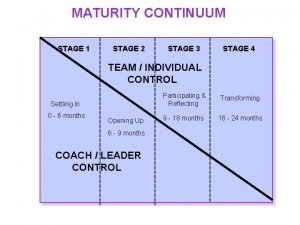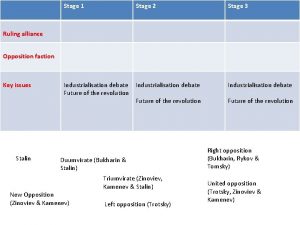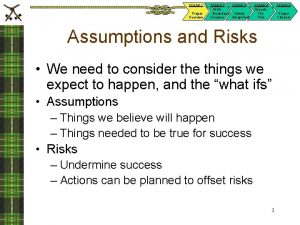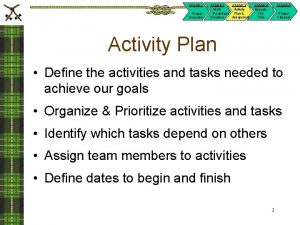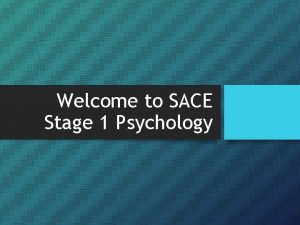HEALTHY MINDS Stage 2 Psychology HEALTHY MINDS A










































































- Slides: 74

HEALTHY MINDS Stage 2 Psychology

HEALTHY MINDS A healthy mind is free from the distressing symptoms of mental illness or a mental disorder. Particular focus on resilience – building mental resilience so our mental health is better. Four levels of explanation: Biological Basic processes Person Socio-cultural

HISTORY OF MENTAL ILLNESS Treatment for mental illness traced back as early as 1550 BC. Evidence suggests not enough distinction between physical and mental illness known. Middle of 19 th century saw push for more humane asylums for mentally ill as psychology advanced. By the mid 1940 s, electric shock therapy, insulin shock therapy and lobotomies common to treat mental illness.

Crash Course Video Clip https: //www. youtube. com/watch? v=wuh. J-Gk. RRQc

MENTAL DISORDER Characterised by behaviours, thoughts and emotions that significantly impair work, study or social functioning. Usually diagnosed by investigating the symptoms that the person reports, observing their behaviour and gaining further evidence from others (family members, GP etc. )

HOW ARE MENTAL DISORDERS DIAGNOSED? Professionals around the world use the DSM-V (Diagnostic and Statistical Manual of the American Psychiatric Associations Manual 5 th edition) to diagnose mental illness. The DSM-V outlines the main diagnoses and related characteristics and statistics relating to all types of mental illness. Diagnosis can only be made by a qualified health professional.

HOW ARE MENTAL DISORDERS DIAGNOSED? People need to have the following to be considered mentally unhealthy Maladaptive behaviour Everyday behaviour is impaired or affected i. e. drugs and alcohol consumed in excess Deviance Clients stage. social and cultural context, as well as developmental Personal Frequent stress. from normal distress diagnosis made on basis of report of great personal

DEPRESSION Healthy Minds

DEPRESSION An extended experience of negative emotions, thoughts, behaviours and functioning for at least two weeks. One of the most common mental health disorders. Each symptom of depression fits into one of the four levels of explanation of behaviour.

DEPRESSION FROM THE 4 LEVELS OF EXPLANATION Healthy Minds

DEPRESSION – BIOLOGICAL Whilst no one is sure how depression develops, change in the brain chemistry is likely. Reduced levels of serotonin (associated with feeling content). Common amongst families, thought to be hereditary. Overuse of substances such as alcohol and drugs is associated with higher vulnerability to depression.

DEPRESSION – BIOLOGICAL Biological Symptoms of Depression Headaches Digestion issues Chronic pain Insomnia Increase or decrease in appetite Imbalance of neurotransmitters (serotonin) Inactive left frontal lobe of brain (during the depression) Genetic inheritance Increased daytime fatigue

DEPRESSION – BASIC PROCESSES Many people with depression have difficulty concentrating and making decisions. Memory is often poorer than normal. Appear to access negative thoughts and emotions more readily than positive ones.

DEPRESSION – BASIC PROCESSES Basic processes symptoms of Depression Feelings of increase sadness/unhappiness Low self esteem Unclear thinking Learned helplessness Depressive thinking styles – pessimistic Thoughts of suicide and/or self harm in serious cases

DEPRESSION - PERSON Research shows people who develop depression have personality types which include: Less flexibility Strongly emotional Worriers Women more likely to be diagnosed with depression than men – vulnerable at beginning of adolescents, childbirth and menopause. Men appear to be more vulnerable at retirement, during long periods of unemployment and following separation from a partner.

DEPRESSION - PERSON Person symptoms of Depression Loss of once pleasurable activities Inflated/deflated sense of self importance Poor judgement Lowered comprehension Impulsivity

DEPRESSION – SOCIO-CULTURAL People without supportive social networks are more vulnerable to depression. In some cultures, depression is considered ‘shameful’ and stigma of mental illness is very apparent.

DEPRESSION – SOCIO-CULTURAL Socio-cultural symptoms of Depression Diminished involvement with others Strained relationships with family and friends Loss of social skills Inappropriate/maladaptive social behaviour Abuse

TREATMENT OF DEPRESSION Usually focused on anti-depression medication (biological) , cognitive behavioural therapy (basic processes) or a combination of both. Medication usually prescribed by a doctor, whereas psychologist will conduct CBT. Danger is becoming dependent on medication for long periods of time. Assertiveness training may help depressive symptoms if caused by workplace (person) Recommended to have strong social network to talk through issues and problems when needed (socio-cultural)

Videos – Beyond Blue website https: //www. youtube. com/watch? v=E 955 JUHf. XSI – women https: //www. youtube. com/watch? time_continue=1&v =XB_DSq. WRce. M - men

ANXIETY Healthy Minds

ANXIETY Many different types of anxiety disorders, however all of them have the experience of strong and/or frequent anxiety or fear. Different anxiety disorders include: Phobias Panic disorder Obsessive-compulsive disorder (OCD) Post traumatic stress disorder (PTSD) Generalised anxiety disorder (GAD) Social phobia

ANXIETY FROM THE 4 LEVELS OF EXPLANATION Healthy Minds

ANXIETY - BIOLOGICAL Flight or fight response much more active. Some research suggests that there are genetic markers for vulnerability to anxiety disorders. Evidence to also support it is genetic.

ANXIETY - BIOLOGICAL Biological Symptoms of Anxiety Headaches Trembling Nausea Muscle tension Dizziness Insomnia Genetic factors Heart palpitations Chest pain Sweating Tingling sensations Hot flushes

ANXIETY – BASIC PROCESSES Classical conditioning can shape some aspects of anxious responses. Anxious people often have interpretation bias where they perceive information form others as negative towards themselves. Often memory is impaired due to inattention to task and worry about other aspects.

ANXIETY – BASIC PROCESSES • Basic Processes Symptoms of Anxiety • Magnify threats and failures • Fear, worrisome thoughts. • Irrational fears • Fear of panic and public scrutiny • Hypersensitive to criticism • Worried about potential mistakes • Avoidance • Persistent unwanted thoughts • Feelings of anxiety, confusion, resentfulness

ANXIETY - PERSON Takes into account an individuals past experiences, personality style, attitudes and beliefs and stress management skills. Women more likely to be diagnosed with anxiety disorders than men.

ANXIETY - PERSON Person Symptoms of Anxiety • Unable to cope • Not confident, focus on perceived threats • High stress levels • Neuroticism

ANXIETY – SOCIO-CULTURAL Anxiety disorders can develop from a traumatic event based a persons social, socio economic, political, religious or cultural affiliation. Examples include: War Abuse Poverty

ANXIETY – SOCIO-CULTURAL Socio-cultural Symptoms of Anxiety • Fast paced lives • Environmental stressors • Decreased job security • Lack of family support • Avoidance of groups, work colleagues etc. • Avoidance of social contact, crowds • Social phobias • Difference between cultures

TREATMENT OF ANXIETY Specific medications called benzodiazepines repress the symptoms of the anxiety response (biological). Only to be taken short term as they can become addictive. CBT considered the most effective treatment of anxiety (and depression) (basic processes). Assertiveness training can be helpful if workplace is the cause of anxiety (person). Good social network again helps to reduce symptoms (socio-cultural).

Videos – Beyond Blue https: //www. youtube. com/watch? time_continue=103 &v=Wn. Anhl. D 9 Wy. Q – Megan’s story https: //www. youtube. com/watch? time_continue=92 &v=RCur 7 ylzk. Gg – Ollie’s story

RISK FACTORS Healthy Minds

RISK FACTORS Research has suggested that there is no one cause of mental illness, alternatively the more risk factors that are present in ones life the greater the chance of that person developing a mental illness Risk factors exist at the biological, person, basic processes and socio-cultural level.

RISK FACTORS

PROTECTIVE FACTORS Healthy Minds

PROTECTIVE FACTORS Protective factors are factors present in one’s life that reduces the likelihood of developing a mental illness Protective factors exist at the biological, person, basic processes and socio-cultural level

PROTECTIVE FACTORS

TASK Identify at least one risk and one protective factor at each of the four levels of explanation.

COPING STRATEGIES Healthy Minds

STRESS MANAGEMENT THERAPY Mainly used as a strategy in treating anxiety during CBT sessions. Psychologists identify triggers, causes and accelerators of stress. Includes many strategies as per recommended by psychologists, including yoga, meditation, time management techniques, saying ‘no’ more often and many more.

Coping Strategies Psychological interventions such as CBT, medication etc. deal directly with mental illness, however there are coping strategies that people can employ to deal with everyday symptoms of depression and anxiety. Coping strategies are things that you can do to help yourself, before seeking help from professionals (if needed)

Coping strategies Physical Exercise (biological) Good sleep hygiene (biological) Nutrition (biological) Challenging negative thoughts (basic processes) Social Involvement (socio-cultural) Planning and problem solving (person and basic processes) Challenging negative thoughts (basic processes) Optimistic/positive outlook (person)

Coping strategies Physical exercise (biological) Can be helpful for depression and ‘down’ emotional state. ‘Burns up’ stress chemicals. Increases self esteem

Coping strategies Nutrition (biological) Lowering fat, salt and sugar intake and increasing protein, vitamin and mineral intake. Circadian rhythms not affected, therefore more energy. Physically feel better

Coping strategies Social involvement (socio-cultural) People with network of friends and family are less likely to experience mental disorders. Sense of belonging. Discussion helps us feel more supported and might help our perception of issue.

Coping strategies Planning and problem solving (learning and person) Writing down how you plan to tackle problems/goals is helpful. Helps to prioritise what is most important and what is not as important at the time. Decide which task/s you can do on your own and which you need help with.

Coping strategies Challenging negative thoughts (basic processes) Often we make predictions of ourselves and we are our own worst enemy. ‘They won’t like me…. ’ ‘I am going to fail……. ’ ‘They are all judging me…. ’ ‘I am stupid……. . ’ Such thoughts can be challenged by thinking of helpful or beneficial ways of thinking about the situation > make us realise they are just perceptions and not reality. E. g. Invitation to a party > ‘No one will talk to me’ > Challenge: I don’t know they wont talk to me; I could invite my friend along; I could just start talking to people etc. ’ > situation does not seem as daunting > more positive outlook.

RESILIENCE Healthy Minds

Resilience is the process of adapting well in the face of adversity, trauma, tragedy, threats or significant sources of stress — such as family and relationship problems, serious health problems or workplace and financial stressors. It means "bouncing back" from difficult experiences.

Resilience Research has shown that resilience is ordinary, not extraordinary. People commonly demonstrate resilience. One example is the response of many Americans to the September 11, 2001 terrorist attacks and individuals' efforts to rebuild their lives.

Resilience Being resilient does not mean that a person doesn't experience difficulty or distress. Emotional pain and sadness are common in people who have suffered major adversity or trauma in their lives. In fact, the road to resilience is likely to involve considerable emotional distress. Resilience is not a trait that people either have or do not have. It involves behaviours, thoughts and actions that can be learned and developed in anyone.

6 Factors in Resilience 1. 2. 3. 4. 5. 6. A combination of factors contributes to resilience. Many studies show that the primary factor in resilience is having caring and supportive relationships within and outside the family. Relationships that create love and trust, provide role models and offer encouragement and reassurance help bolster a person's resilience. Several additional factors are associated with resilience, including: The capacity to make realistic plans and take steps to carry them out. A positive view of yourself and confidence in your strengths and abilities. Skills in communication and problem solving. The capacity to manage strong feelings and impulses.

10 ways to build resilience Make connections. Good relationships with close family members, friends or others are important. Accepting help and support from those who care about you and will listen to you strengthens resilience. Some people find that being active in civic groups, faith-based organizations, or other local groups provides social support and can help with reclaiming hope. Assisting others in their time of need also can benefit the helper. Avoid seeing crises as insurmountable problems. You can't change the fact that highly stressful events happen, but you can change how you interpret and respond to these events. Try looking beyond the present to how future circumstances may be a little better. Note any subtle ways in which you might already feel somewhat better as you deal with difficult situations.

10 ways to build resilience Accept that change is a part of living. Certain goals may no longer be attainable as a result of adverse situations. Accepting circumstances that cannot be changed can help you focus on circumstances that you can alter. Move toward your goals. Develop some realistic goals. Do something regularly — even if it seems like a small accomplishment — that enables you to move toward your goals. Instead of focusing on tasks that seem unachievable, ask yourself, "What's one thing I know I can accomplish today that helps me move in the direction I want to go? "

10 ways to build resilience Take decisive actions. Act on adverse situations as much as you can. Take decisive actions, rather than detaching completely from problems and stresses and wishing they would just go away. Look for opportunities for self-discovery. People often learn something about themselves and may find that they have grown in some respect as a result of their struggle with loss. Many people who have experienced tragedies and hardship have reported better relationships, greater sense of strength even while feeling vulnerable, increased sense of self-worth, a more developed spirituality and heightened appreciation for life.

10 ways to build resilience Nurture a positive view of yourself. Developing confidence in your ability to solve problems and trusting your instincts helps build resilience. Keep things in perspective. Even when facing very painful events, try to consider the stressful situation in a broader context and keep a long-term perspective. Avoid blowing the event out of proportion. Maintain a hopeful outlook. An optimistic outlook enables you to expect that good things will happen in your life. Try visualizing what you want, rather than worrying about what you fear.

10 ways to build resilience Take care of yourself. Pay attention to your own needs and feelings. Engage in activities that you enjoy and find relaxing. Exercise regularly. Taking care of yourself helps to keep your mind and body primed to deal with situations that require resilience. Additional ways of strengthening resilience may be helpful. For example, some people write about their deepest thoughts and feelings related to trauma or other stressful events in their life. Meditation and spiritual practices help some people build connections and restore hope. The key is to identify ways that are likely to work well for you as part of your own personal strategy for fostering resilience.

PSYCHOLOGICAL INTERVENTIONS FOR MENTAL ILLNESS Healthy Minds

Psychological Interventions There a range of psychological interventions used to treat mental illness. Many of the interventions you have looked at throughout the year Review the following interventions CBT (basic processes) Assertiveness Training (person) Systematic Desensitisation (basic processes) ECT (biological) Drug Treatment (biological)

COGNITIVE BEHAVIOUR THERAPY Used extensively in the treatment of anxiety and depression Most recognised and effective psychological therapy Teaches client to understand, manage and change their thoughts and actions Helps client become aware of thought distortions Through CBT, client learns coping strategies Improved skills of awareness, introspection and evaluation Reduces likelihood of relapse

CBT Advantages Evidence for longer, more extended success Can use strategies again if symptoms resurface Disadvantages Sometimes difficult to change thought process for severe depression and/or anxiety Can be very confronting being diagnosed Can be very expensive

SYSTEMATIC DESENSITISATION Form of behaviour therapy used to treat phobias and other behaviour problems involving anxiety. Based on Classical Conditioning Aim is to condition relaxation with feared item/object Three steps involved: 1. Relaxation techniques 2. Developing anxiety hierarchy 3. Pairing

SYSTEMATIC DESENSITISATION Advantage Gradual process of extinguishing strong conditioned response Disadvantages Can be very slow process

Methods of collecting data Clinical interviews Uses qualitative data to gain more information and make possible diagnosis. Self-reports Diaries, rating scales etc. Uses subjective quantitative and qualitative data. Objective quantitative methods EEG machines, heart rates, blood pressure, blood tests etc.

Ethics There is a duty of care and ethical code for professionals working with people who have a mental illness to protect their rights and dignities Diagnosis of mental illness is far from straightforward and adequate evidence needs to be compiled before a diagnosis should be made There is still great stigma in society towards mental illness, largely because people misunderstand mental illness Diagnosis of a mental illness can be both helpful and harmful.

Ethics There is no evidence to suggest there is a link between mental illness and violence, and this notion should not be used to reinforce stigma and discrimination against these people Diagnosis is fraught with difficulty, so to is treatment and what is most effective for patients There are laws in place to protect people with a mental illness, this may mean involuntary admission to a psychiatric ward if people are considered a danger to themselves or others, however most psychiatric wards in Australia have a majority of patients that are there on a voluntary basis.

AREAS OF LEARNING Healthy Minds

AREAS OF LEARNING Effective coping strategies; the factors that influence resilience; protective factors for mental health; symptoms of, and effective treatment for, anxiety disorders and depression; and the relationships between factors at the biological, basic processes, person, and sociocultural levels of explanation of behaviour in the psychology of healthy minds and mental health issues

AREAS OF LEARNING Psychological principles concerning healthy minds in everyday experiences and events (e. g. cultural and historical differences in concepts of mental health and mental illness) and in psychological interventions, including cognitive-behavioural therapy; behaviour modification; systematic desensitisation of phobias; assertiveness training; therapy for insomnia; and stress management therapy

AREAS OF LEARNING The application of principles from the psychology of healthy minds to social issues (e. g. preventing the development of mental disorders, and reducing prejudice against people with a mental illness) and personal growth, including the advantages and disadvantages of different psychological interventions

AREAS OF LEARNING Investigation designs and methods for assessing psychological responses used to study healthy minds and mental disorders; and investigation designs and methods used to evaluate psychological interventions

AREAS OF LEARNING Ethical issues associated with research and applications in the area of healthy minds and mental health issues
 Healthy food healthy mind journal
Healthy food healthy mind journal Healthy soil healthy life poster ideas
Healthy soil healthy life poster ideas Healthy community poster
Healthy community poster Healthy nurse healthy nation
Healthy nurse healthy nation 1. denial
1. denial Stage left
Stage left Type of stage
Type of stage Disadvantages of two stage tendering
Disadvantages of two stage tendering Downstage and upstage
Downstage and upstage Upstage vs downstage
Upstage vs downstage Anal personality
Anal personality Sigmund freud psychodynamic theory
Sigmund freud psychodynamic theory Phallic character
Phallic character Positive psychology ap psychology definition
Positive psychology ap psychology definition Two factor theory psychology
Two factor theory psychology Social psychology ap psychology
Social psychology ap psychology History and origin of science of psychology slideshare
History and origin of science of psychology slideshare Social psychology is the scientific study of:
Social psychology is the scientific study of: Health psychology definition ap psychology
Health psychology definition ap psychology Winning hearts and minds manchester
Winning hearts and minds manchester Dirty minds quiz
Dirty minds quiz Summary of the men we carry in our minds
Summary of the men we carry in our minds Starling minds
Starling minds Andrew gonce
Andrew gonce Laying the foundation for a quality culture
Laying the foundation for a quality culture Nx mentoring
Nx mentoring Difference between invention and discovery
Difference between invention and discovery Inquiring minds want to know
Inquiring minds want to know Themes in macbeth
Themes in macbeth Big 5 personality test similar minds
Big 5 personality test similar minds Thinking feeling
Thinking feeling Risk minds conference amsterdam
Risk minds conference amsterdam Empowering minds curriculum
Empowering minds curriculum The best minds of my generation
The best minds of my generation Other minds problem
Other minds problem Dyscalculia simulation activity
Dyscalculia simulation activity Five minds
Five minds App marketing minds
App marketing minds The best minds of my generation
The best minds of my generation What comes into our minds when we think about god
What comes into our minds when we think about god Robomind scripts
Robomind scripts Like minds like mine
Like minds like mine Curious minds want to know
Curious minds want to know Risk minds asia
Risk minds asia Stay pure meaning
Stay pure meaning Kindred minds
Kindred minds Curious minds want to know
Curious minds want to know Ef educational tours
Ef educational tours Inquiring minds definition
Inquiring minds definition Developing minds by art costa
Developing minds by art costa Aspiring minds pricing
Aspiring minds pricing Minds are like parachutes
Minds are like parachutes Let me not to the marriage of true
Let me not to the marriage of true Five minds
Five minds Branching minds waco isd
Branching minds waco isd Young minds resilience
Young minds resilience Academic resilience approach
Academic resilience approach Healthy lifestyle wrap up lecture
Healthy lifestyle wrap up lecture What is healthy active living
What is healthy active living Superlative healthy
Superlative healthy Characteristics of mentally healthy person
Characteristics of mentally healthy person Healthy by dori
Healthy by dori Psychodynamic theory
Psychodynamic theory The national healthy childhood programme
The national healthy childhood programme The diet full poem
The diet full poem Healthy relationships
Healthy relationships Healthy food in charlotte
Healthy food in charlotte Staying healthy assessment
Staying healthy assessment Objectives of healthy food
Objectives of healthy food Lesson 3: keeping the family healthy
Lesson 3: keeping the family healthy Healthy relationships jeopardy
Healthy relationships jeopardy Healthy relationship lesson plans
Healthy relationship lesson plans Dc healthy families
Dc healthy families Healthy homes liverpool
Healthy homes liverpool Foundations of a healthy relationship
Foundations of a healthy relationship








